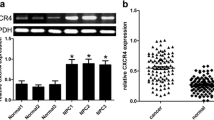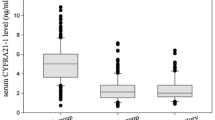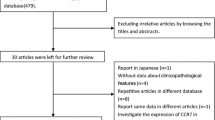Abstract
Background
Nasopharyngeal carcinoma (NC) is a malignant human tumor with a high incidence that occurs on the top and lateral wall of the nasopharynx.
Aims
To investigate the clinical value of chemokine receptor 7 (CCR7) in locally advanced NC.
Methods
We enrolled 114 patients with locally advanced NC admitted to our hospital in the observation group (OBG) and 100 normal healthy subjects who underwent physical examination in the control group (COG). The serum CCR7 expression levels in each group were measured using enzyme-linked immunosorbent assay and were compared between the groups.
Results
None of the 114 patients or their family members were lost during follow-up. Thirty-five patients died within 3 years and 79 survived (survival rate: 69.29%). The serum CCR7 level was higher in the OBG than in the COG (P < 0.05). The receiver operating characteristic (ROC) curve showed that the area under the ROC curve (AUC) was 0.837 for diagnostic value for locally advanced NC and the AUC was 0.759 for predictive value for 3-year mortality. The CCR7 AUC for diagnosis of locally advanced NC was 0.837 and for prediction of mortality was 0.759. Univariate analysis revealed significant differences in smoking history, long-term consumption of pickled food, family history of NC, primary lesion staging, lymph node staging, distant metastasis, clinical pathological staging, and CCR7 between the two groups (P < 0.05).
Conclusions
CCR7 was valuable in the diagnosis of locally advanced NC, and highly expressed CCR7 was predictive of poor prognosis.




Similar content being viewed by others
References
Paul P, Deka H, Malakar AK, Halder B, Chakraborty S (2018) Nasopharyngeal carcinoma: understanding its molecular biology at a fine scale. Eur J Cancer Prev 27(1):33–41. https://doi.org/10.1097/CEJ.0000000000000314
Bruce JP, Yip K, Bratman SV, Ito E, Liu FF (2015) Nasopharyngeal cancer: molecular landscape. J Clin Oncol 33(29):3346–3355. https://doi.org/10.1200/JCO.2015.60.7846
Li L, Gu M, Bo Y, Shi S, Shan Y, Bao L, Yiwen YJCS (2016) Long non-coding RNA ROR promotes proliferation, migration and chemoresistance of nasopharyngeal carcinoma. 107(9):1215–1222
Tang Y, He Y, Shi L, Yang L, Wang J, Lian Y, Fan C, Zhang P, Guo C, Zhang S, Gong Z, Li X, Xiong F, Li X, Li Y, Li G, Xiong W, Zeng Z (2017) Co-expression of AFAP1-AS1 and PD-1 predicts poor prognosis in nasopharyngeal carcinoma. Oncotarget 8(24):39001–39011. https://doi.org/10.18632/oncotarget.16545
Qiu WZ, Huang PY, Shi JL, Xia HQ, Zhao C, Cao KJ (2016) Neoadjuvant chemotherapy plus intensity-modulated radiotherapy versus concurrent chemoradiotherapy plus adjuvant chemotherapy for the treatment of locoregionally advanced nasopharyngeal carcinoma: a retrospective controlled study. Chin J Cancer 35:2. https://doi.org/10.1186/s40880-015-0076-9
Li X, Lin Y, Yang X, Wu X, He X (2016) Long noncoding RNA H19 regulates EZH2 expression by interacting with miR-630 and promotes cell invasion in nasopharyngeal carcinoma. Biochem Biophys Res Commun 473(4):913–919. https://doi.org/10.1016/j.bbrc.2016.03.150
Borroni EM, Savino B, Bonecchi R, Locati M (2018) Chemokines sound the alarmin: the role of atypical chemokine in inflammation and cancer. Semin Immunol 38:63–71. https://doi.org/10.1016/j.smim.2018.10.005
Mashino K, Sadanaga N, Yamaguchi H, Tanaka F, Ohta M, Shibuta K, Inoue H, Mori M (2002) Expression of chemokine receptor CCR7 is associated with lymph node metastasis of gastric carcinoma. Cancer Res 62(10):2937–2941
Ohl L, Mohaupt M, Czeloth N, Hintzen G, Kiafard Z, Zwirner J, Blankenstein T, Henning G, Forster R (2004) CCR7 governs skin dendritic cell migration under inflammatory and steady-state conditions. Immunity 21(2):279–288. https://doi.org/10.1016/j.immuni.2004.06.014
Tang G, Du R, Tang Z, Kuang Y (2018) MiRNALet-7a mediates prostate cancer PC-3 cell invasion, migration by inducing epithelial-mesenchymal transition through CCR7/MAPK pathway. 119(4)
Li X, Sun S, Li N, Gao J, Yu J, Zhao J, Li M, Zhao Z (2017) High expression of CCR7 predicts lymph node metastasis and good prognosis in triple negative breast cancer. Cell Physiol Biochem 43(2):531–539. https://doi.org/10.1159/000480526
Du P, Liu Y, Ren H, Zhao J, Zhang X, Patel R, Hu C, Gan J, Huang G (2017) Expression of chemokine receptor CCR7 is a negative prognostic factor for patients with gastric cancer: a meta-analysis. Gastric Cancer 20(2):235–245. https://doi.org/10.1007/s10120-016-0602-8
Jiang C, Chen J, Xie S, Zhang L, Xiang Y, Lung M, Kam NW, Kwong DL, Cao S, Guan XY (2018) Evaluation of circulating EBV microRNA BART2-5p in facilitating early detection and screening of nasopharyngeal carcinoma. Int J Cancer 143(12):3209–3217. https://doi.org/10.1002/ijc.31642
Xu S, Li Y, Lu Y, Huang J, Ren J, Zhang S, Yin Z, Huang K, Wu G, Yang K (2018) LZTS2 inhibits PI3K/AKT activation and radioresistance in nasopharyngeal carcinoma by interacting with p85. Cancer Lett 420:38–48. https://doi.org/10.1016/j.canlet.2018.01.067
Tang LL, Chen WQ, Xue WQ, He YQ, Zheng RS, Zeng YX, Jia WH (2016) Global trends in incidence and mortality of nasopharyngeal carcinoma. Cancer Lett 374(1):22–30. https://doi.org/10.1016/j.canlet.2016.01.040
Kim KY, Le QT, Yom SS, Ng RHW, Chan KCA, Bratman SV, Welch JJ, Divi RL, Petryshyn RA, Conley BA (2017) Clinical utility of Epstein-Barr virus DNA testing in the treatment of nasopharyngeal carcinoma patients. Int J Radiat Oncol Biol Phys 98(5):996–1001. https://doi.org/10.1016/j.ijrobp.2017.03.018
Xu Y, Chen X, Zhang M, Xiao Y, Zong J, Guo Q, Qiu S, Zheng W, Lin S, Pan J (2017) Prognostic effect of parotid area lymph node metastases after preliminary diagnosis of nasopharyngeal carcinoma: a propensity score matching study. Cancer Med 6(10):2213–2221. https://doi.org/10.1002/cam4.1154
Xu P, Min Y, Blanchard P, Feng M, Zhang P, Luo Y, Fan Z, Lang J (2017) Incidence of small lymph node metastases in patients with nasopharyngeal carcinoma: clinical implications for prognosis and treatment. Head Neck 39(2):305–310. https://doi.org/10.1002/hed.24586
Miller MC, Mayo KH (2017) Chemokines from a structural perspective. Int J Mol Sci 18(10). https://doi.org/10.3390/ijms18102088
Liao X, Pirapakaran T, Luo XM (2016) Chemokines and chemokine receptors in the development of lupus nephritis. Mediat Inflamm 2016:6012715. https://doi.org/10.1155/2016/6012715
Franciszkiewicz K, Boissonnas A, Boutet M, Combadiere C, Mami-Chouaib F (2012) Role of chemokines and chemokine receptors in shaping the effector phase of the antitumor immune response. Cancer Res 72(24):6325–6332. https://doi.org/10.1158/0008-5472.CAN-12-2027
Valverde-Villegas JM, de Medeiros RM, de Andrade KP, Jacovas VC, Dos Santos BR, Simon D, Se DMA, Jab CJA (2017) Novel genetic associations and gene-gene interactions of chemokine receptor and chemokine genetic polymorphisms in HIV/AIDS. 31(9):–1
Hauser MA, Legler DF (2016) Common and biased signaling pathways of the chemokine receptor CCR7 elicited by its ligands CCL19 and CCL21 in leukocytes. J Leukoc Biol 99(6):869–882. https://doi.org/10.1189/jlb.2MR0815-380R
Cho ES, Kang HE, Kim NH, Yook JI (2019) Therapeutic implications of cancer epithelial-mesenchymal transition (EMT). Arch Pharm Res 42(1):14–24. https://doi.org/10.1007/s12272-018-01108-7
Tsoumas D, Nikou S, Giannopoulou E, Champeris Tsaniras S, Sirinian C, Maroulis I, Taraviras S, Zolota V, Kalofonos HP, Bravou V (2018) ILK expression in colorectal cancer is associated with EMT, cancer stem cell markers and chemoresistance. Cancer Genomics Proteomics 15(2):127–141. https://doi.org/10.21873/cgp.20071
Saitoh M (2018) Involvement of partial EMT in cancer progression. J Biochem 164(4):257–264. https://doi.org/10.1093/jb/mvy047
Brummer G, Acevedo DS, Hu Q, Portsche M, Fang WB, Yao M, Zinda B, Myers M, Alvarez N, Fields P, Hong Y, Behbod F, Cheng N (2018) Chemokine signaling facilitates early-stage breast cancer survival and invasion through fibroblast-dependent mechanisms. Mol Cancer Res 16(2):296–308. https://doi.org/10.1158/1541-7786.MCR-17-0308
Zhou B, Xu H, Ni K, Ni X, Shen J (2016) Expression of chemokine XCL2 and CX3CL1 in lung cancer. Med Sci Monit 22:1560–1565. https://doi.org/10.12659/msm.895985
Tutunea-Fatan E, Majumder M, Xin X, Lala PK (2015) The role of CCL21/CCR7 chemokine axis in breast cancer-induced lymphangiogenesis. Mol Cancer 14:35. https://doi.org/10.1186/s12943-015-0306-4
Zhu L, Luo K, Gu XH, Hou N, Huang CP, Lou Q, Dai XZ, Zhang K (2015) CXCR7 expression in nasopharyngeal carcinoma tissues correlates with disease severity. Int J Clin Exp Med 8(11):21257–21261
Author information
Authors and Affiliations
Corresponding author
Ethics declarations
Conflict of interest
The authors declare that they have no conflict of interest.
Ethical approval
This study was approved by the ethics committee of Jingzhou Hospital, Tongji Medical College, Huazhong University of Science and Technology.
Informed consent
Informed consent was obtained from all individual participants included in the study.
Additional information
Publisher’s note
Springer Nature remains neutral with regard to jurisdictional claims in published maps and institutional affiliations.
Min Shen and Lingling Yi are co-first authors.
Rights and permissions
About this article
Cite this article
Shen, M., Yi, L. & Jiang, Y. Highly expressed CCR7 predicts poor prognosis in locally advanced nasopharyngeal carcinoma. Ir J Med Sci 189, 669–676 (2020). https://doi.org/10.1007/s11845-019-02141-1
Received:
Accepted:
Published:
Issue Date:
DOI: https://doi.org/10.1007/s11845-019-02141-1




